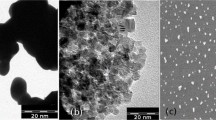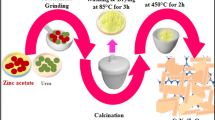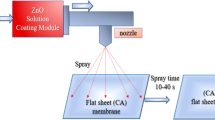Abstract
In the face of severe environmental problems and resource shortage in the world today, photocatalysis technology has attracted much attention because of its green, efficient and environmentally friendly advantages. Photocatalysis converts solar energy into chemistry energy, which can be applied to water decomposition to produce hydrogen, degradation of organic contamination, CO2 reduction, organic synthesis and other fields. In this paper, poly(dopamine)@carbon nitride (PDA@CN) was synthesized by dopamine self-polymerization on the surface of g-C3N4 and the PVA/PDA@CN composite antibacterial nanofiber membranes were successfully prepared by electrospinning with PVA solution doped with PDA@CN. PDA can play a role in light absorption, electron transfer and adhesion interface. The results showed that PDA had an effect on the light-harvesting ability of PDA@CN, and the visible light capturing ability of PDA@CN increased. From the inhibition results, it could be seen that the PVA/PDA@CN nanofiber membranes with 5% PDA@CN had good inhibition effect on E. coli and S. aureus under visible light irradiation and the maximum inhibition circle radius could reach 10.8 mm and 11.6 mm, respectively, and the inhibition rate of E. coli could be up to 93.1%. According to the results of photocatalytic degradation experiments, the obtained PVA/PDA@CN membranes showed enhanced photocatalytic degradation efficiency under visible light. When the PDA@CN content was 5 wt.%, the removal rate of MB by PVA/PDA@CN membrane reached 98.7%. In addition, the membrane had good thermal stability and excellent mechanical properties, which had great potential for future applications in many fields.









Similar content being viewed by others
Data Availability
Data are available on request from the corresponding author.
References
Cui SS, Liu X, Shi YB et al (2022) Construction of atomic-level charge transfer channel in Bi12O17Cl2/MXene heterojunctions for improved visible-light photocatalytic performance. Rare Met 41:2405–2416. https://doi.org/10.1007/s12598-022-02011-3
Liang X, Dai R, Chang S et al (2022) Antibacterial mechanism of biogenic calcium oxide and antibacterial activity of calcium oxide/polypropylene composites. Colloids Surf A 650:129446. https://doi.org/10.1016/j.colsurfa.2022.129446
Zhang R, Li Q, Yang L et al (2022) The antibacterial activity and antibacterial mechanism of the tea polyphenol liposomes/lysozyme–chitosan gradual sustained release composite coating. Int J Food Sci Technol 57:3691–3701. https://doi.org/10.1111/ijfs.15694
Shi Y, Evans JE, Rock KL (2003) Molecular identification of a danger signal that alerts the immune system to dying cells. Nature 425:516–521. https://doi.org/10.1038/nature01991
Qi J, Wu J, Chen J et al (2019) An investigation of the thermal and (bio)degradability of PBS copolyesters based on isosorbide. Polym Degrad Stab 160:229–241. https://doi.org/10.1016/j.polymdegradstab.2018.12.031
Niiyama E, Uto K, Ebara M (2019) Electrospun PCL-PCL polyblend nanofibers with high- and low-molecular weight for controlled degradation. Chem Lett 48:623–626. https://doi.org/10.1246/cl.190100
Liu M, Jiao Y, Qin J et al (2021) Boron doped C3N4 nanodots/nonmetal element (S, P, F, Br) doped C3N4 nanosheets heterojunction with synergistic effect to boost the photocatalytic hydrogen production performance. Appl Surf Sci 541:148558. https://doi.org/10.1016/j.apsusc.2020.148558
Zeng X, Liu Y, Kang Y et al (2020) Simultaneously tuning charge separation and oxygen reduction pathway on graphitic carbon nitride by polyethylenimine for boosted photocatalytic hydrogen peroxide production. ACS Catal 10:3697–3706. https://doi.org/10.1021/acscatal.9b05247
Yang Y, Zhang D, Fan J et al (2021) Construction of an Ultrathin S-Scheme Heterojunction Based on Few-Layer g-C3N4 and Monolayer Ti3C2Tx MXene for Photocatalytic CO2 Reduction. Solar RRL 5:2000351. https://doi.org/10.1002/solr.202000351
Jana A, Kumari K, Dey A et al (2019) Fabrication of P-N heterojunction based MoS2 modified CuPc nanoflowers for humidity sensing. Sens Actuators A: Phys 299:111574. https://doi.org/10.1016/j.sna.2019.111574
Xiao Y, Abulizi A, Okitsu K et al (2023) Facile fabrication of SnO2 modified hierarchical BiOI S-scheme heterojunction photocatalyst with efficient activity for carbon dioxide reduction. J Ind Eng Chem 125:317–324. https://doi.org/10.1016/j.jiec.2023.05.041
Xiao G, Xu S, Li P et al (2018) Visible-light-driven activity and synergistic mechanism of TiO2@g-C3N4 heterostructured photocatalysts fabricated through a facile and green procedure for various toxic pollutants removal. Nanotechnology 29:315601. https://doi.org/10.1088/1361-6528/aac304
Saidin S, Jumat MA, Mohd Amin NAA et al (2021) Organic and inorganic antibacterial approaches in combating bacterial infection for biomedical application. Mater Sci Eng C Mater Biol Appl 118:111382. https://doi.org/10.1016/j.msec.2020.111382
Tang C, Liu C, Han Y et al (2019) Nontoxic carbon quantum dots/g-C3N4 for efficient photocatalytic inactivation of staphylococcus aureus under visible light. Adv Healthc Mater 8:e1801534. https://doi.org/10.1002/adhm.201801534
Ma S, Zhan S, Jia Y et al (2016) Enhanced disinfection application of Ag-modified g-C3N4 composite under visible light. Appl Catal B 186:77–87. https://doi.org/10.1016/j.apcatb.2015.12.051
Zhang Y, Antonietti M (2010) Photocurrent generation by polymeric carbon nitride solids: an initial step towards a novel photovoltaic system. Chem Asian J 5:1307–1311. https://doi.org/10.1002/asia.200900685
Ashfaq A, Ikram M, Haider A et al (2021) Nitrogen and carbon nitride-doped TiO2 for multiple catalysis and its antimicrobial activity. Nanoscale Res Lett 16:119. https://doi.org/10.1186/s11671-021-03573-4
Zhu B, Zhang L, Cheng B et al (2018) First-principle calculation study of tri-s-triazine-based g-C3N4: A review. Appl Catal B 224:983–999. https://doi.org/10.1016/j.apcatb.2017.11.025
Wang X, Blechert S, Antonietti M (2012) Polymeric graphitic carbon nitride for heterogeneous photocatalysis. ACS Catal 2:1596–1606. https://doi.org/10.1021/cs300240x
Qu J, Gao S, Hou Z (2022) Study on the modification of polyvinylidene fluoride with polyurethane to achieve excellent hydrophilic property. Main Group Chem 21:481–489. https://doi.org/10.3233/MGC-210135
Huang J, Hu J, Shi Y et al (2019) Evaluation of self-cleaning and photocatalytic properties of modified g-C3N4 based PVDF membranes driven by visible light. J Colloid Interface Sci 541:356–366. https://doi.org/10.1016/j.jcis.2019.01.105
Hou J, Liu S, Jiang X et al (2021) Polyaniline/graphite carbon nitride composite coatings with outstanding photo-induced anodic antifouling and antibacterial properties under visible light. Prog Org Coat 154:106203. https://doi.org/10.1016/j.porgcoat.2021.106203
Ma Y, Chen R, Fei G et al (2022) Enhanced anti-aging and anti-corrosion performance of waterborne epoxy coating layers over the dual effects of g-C3N4 photocatalysis. J Appl Polym Sci 139:52356. https://doi.org/10.1002/app.52356
Ge JC, Wu G, Yoon SA-O et al (2021) Study on the preparation and lipophilic properties of polyvinyl alcohol (PVA) Nanofiber membranes via green electrospinning. Nanomaterials. https://doi.org/10.3390/nano11102514
Pervez MN, Stylios GK, Liang Y et al (2020) Low-temperature synthesis of novel polyvinylalcohol (PVA) nanofibrous membranes for catalytic dye degradation. J Clean Prod 262:121301. https://doi.org/10.1016/j.jclepro.2020.121301
Bai X, Song T, Luan J et al (2023) Polyvinyl alcohol/chitosan nanofiber membranes loaded with oxygenated graphitic carbon nitride nanosheets for enhanced photocatalytic bacteriostasis. J Appl Polym Sci. https://doi.org/10.1002/app.54081
He X, Shang H, Wang C et al (2021) Significantly influenced photocatalytic performance for H2O2 generation over ultrathin g-C3N4 through regulating the migration orientation of photogenerated charge carriers. Chin Chem Lett 32:3377–3381. https://doi.org/10.1016/j.cclet.2021.04.028
Wu Y, Zhou Y, Xu H et al (2018) Highly active, superstable, and biocompatible Ag/Polydopamine/g-C3N4 bactericidal photocatalyst: synthesis, characterization, and mechanism. ACS Sustain Chem Eng 6:14082–14094. https://doi.org/10.1021/acssuschemeng.8b02620
Augustine R, Hasan A, Yadu Nath VK et al (2018) Electrospun polyvinyl alcohol membranes incorporated with green synthesized silver nanoparticles for wound dressing applications. J Mater Science: Mater Med 29:163. https://doi.org/10.1007/s10856-018-6169-7
Suganthi S, Vignesh S, Kalyana Sundar J et al (2020) Fabrication of PVA polymer films with improved antibacterial activity by fine-tuning via organic acids for food packaging applications. Appl Water Sci 10:100. https://doi.org/10.1007/s13201-020-1162-y
Fan L, Zhang H, Gao M et al (2019) Cellulose nanocrystals/silver nanoparticles: in-situ preparation and application in PVA films. Holzforschung. https://doi.org/10.1515/hf-2018-0251
Bai X, Luan J, Song T et al (2023) Chitosan-grafted carbon oxynitride nanoparticles: investigation of photocatalytic degradation and antibacterial activity. Polymers 15:1688. https://doi.org/10.3390/polym15071688
Zhang H, Zhang X, Zhu M et al (2020) Antibacterial performance of a gold-loaded g-C3N4 nanocomposite system in visible light-dark dual mode. ChemPlusChem 85:2722–2730. https://doi.org/10.1002/cplu.202000676
Liu T, Lu Z, Zhai H et al (2023) Hierarchical porous PLLA@TiO2 fibrous membrane for enhanced and stable photocatalytic degradation efficiency. ACS ES&T Water 3:342–353. https://doi.org/10.1021/acsestwater.2c00424
Balakumar V, Ramalingam M, Sekar K et al (2021) Fabrication and characterization of carbon quantum dots decorated hollow porous graphitic carbon nitride through polyaniline for photocatalysis. Chem Eng J 426:131739. https://doi.org/10.1016/j.cej.2021.131739
Yu C, Tan L, Shen S et al (2021) In situ preparation of g-C3N4/polyaniline hybrid composites with enhanced visible-light photocatalytic performance. J Environ Sci (China) 104:317–325. https://doi.org/10.1016/j.jes.2020.08.024
Kang Y, Yang Y, Yin LC et al (2016) Selective breaking of hydrogen bonds of layered carbon nitride for visible light photocatalysis. Adv Mater 28:6471–6477. https://doi.org/10.1002/adma.201601567
Yu Z, Li F, Yang Q et al (2017) Nature-mimic method to fabricate polydopamine/graphitic carbon nitride for enhancing photocatalytic degradation performance. ACS Sustain Chem Eng 5:7840–7850. https://doi.org/10.1021/acssuschemeng.7b01313
Ma TY, Tang Y, Dai S et al (2014) Proton-functionalized two-dimensional graphitic carbon nitride nanosheet: an excellent metal-/label-free biosensing platform. Small 10:2382–2389. https://doi.org/10.1002/smll.201303827
Dante RC, Martín-Ramos P, Navas-Gracia LM et al (2013) Polymeric carbon nitride nanosheets. J Macromolecular Sci Part B 52:623–631. https://doi.org/10.1080/00222348.2012.716336
Sun S, Li C, Sun Z et al (2021) In-situ design of efficient hydroxylated SiO2/g-C3N4 composite photocatalyst: Synergistic effect of compounding and surface hydroxylation. Chem Eng J 416:129107. https://doi.org/10.1016/j.cej.2021.129107
Gong Z, Chen L, Chen K et al (2023) Significantly improved photocatalytic H2O2 generation over PDA-modified g-C3N4 via promoting charge-carriers separation and oxygen adsorption. J Environ Chem Eng 11:109405. https://doi.org/10.1016/j.jece.2023.109405
Xie A, Zhang K, Wu F et al (2016) Polydopamine nanofilms as visible light-harvesting interfaces for palladium nanocrystal catalyzed coupling reactions. Catal Sci Technol 6:1764–1771. https://doi.org/10.1039/C5CY01330E
Wu Y, Ding W, Li J (2021) Fabrication of hierarchical nanocomposites through a nature-mimic method: depositing MoS2 nanoparticles on carbon nitride nanotubes by polydopamine coating. J Nanomater. https://doi.org/10.1155/2021/6668393
Liu XBY, Chen M (2023) Polyvinyl alcohol/graphitic carbon nitride composite nanofiber membrane with enhanced antibacterial activity under visible light excitation. Polym Mater Sci Eng 39:71–79. https://doi.org/10.16865/j.cnki.1000-7555.2023.0029
Liu Y, Ai K, Lu L (2014) Polydopamine and its derivative materials: synthesis and promising applications in energy, environmental, and biomedical fields. Chem Rev 114:5057–5115. https://doi.org/10.1021/cr400407a
Li B, Gao X, Qu J et al (2022) Visible-light-driven antimicrobial activity and mechanism of polydopamine-reduced graphene oxide/BiVO4 composite. Int J Mol Sci 23:7712. https://doi.org/10.3390/ijms23147712
Bao S, Gao J, Xu T et al (2021) Anti-freezing and antibacterial conductive organohydrogel co-reinforced by 1D silk nanofibers and 2D graphitic carbon nitride nanosheets as flexible sensor. Chem Eng J 411:128470. https://doi.org/10.1016/j.cej.2021.128470
Kong X, Liu X, Zheng Y et al (2021) Graphitic carbon nitride-based materials for photocatalytic antibacterial application. Mater Sci Engineering: R: Rep 145:100610. https://doi.org/10.1016/j.mser.2021.100610
He D, Zhang Z, Xing Y et al (2020) Black phosphorus/graphitic carbon nitride: a metal-free photocatalyst for green photocatalytic bacterial inactivation under visible light. Chem Eng J 384:123258. https://doi.org/10.1016/j.cej.2019.123258
Cao Z, Luo Y, Li Z et al (2021) Antibacterial hybrid hydrogels. Macromol Biosci 21:2000252. https://doi.org/10.1002/mabi.202000252
Wang Y, Lin L, Li F et al (2016) Enhanced photocatalytic bacteriostatic activity towards Escherichia coli using 3D hierarchical microsphere BiOI/BiOBr under visible light irradiation. Photochem Photobiol Sci 15:666–672. https://doi.org/10.1039/c5pp00406c
Sun L, Du T, Hu C et al (2017) Antibacterial activity of graphene oxide/g-C3N4 composite through photocatalytic disinfection under visible light. ACS Sustain Chem Eng 5:8693–8701. https://doi.org/10.1021/acssuschemeng.7b01431
Zhao H, Yu H, Quan X et al (2014) Fabrication of atomic single layer graphitic-C3N4 and its high performance of photocatalytic disinfection under visible light irradiation. Appl Catal B 152–153:46–50. https://doi.org/10.1016/j.apcatb.2014.01.023
Xiao W, Huang Z, Tang Y et al (2023) Effect of nano-Ag proportion on the structure of Ag– TiO2–Bi2WO6 photocatalyst and its antibacterial property on Escherichia coli. Opt Mater 137:113539. https://doi.org/10.1016/j.optmat.2023.113539
Liu T, Li L, Geng X et al (2022) Heterostructured MXene-derived oxides as superior photocatalysts for MB degradation. J Alloys Compd 919:165629. https://doi.org/10.1016/j.jallcom.2022.165629
Nambiar AP, Pillai R, Vadikkeettil Y et al (2022) Glutaraldehyde-crosslinked poly(vinyl alcohol)/halloysite composite films as adsorbent for methylene blue in water. Mater Chem Phys 291:126752. https://doi.org/10.1016/j.matchemphys.2022.126752
Jaseela PK, Garvasis J, Joseph A (2019) Selective adsorption of methylene blue (MB) dye from aqueous mixture of MB and methyl orange (MO) using mesoporous titania (TiO2) – poly vinyl alcohol (PVA) nanocomposite. J Mol Liq 286:110908. https://doi.org/10.1016/j.molliq.2019.110908
Zidan HM, El-Ghamaz NA, Abdelghany AM et al (2018) Photodegradation of methylene blue with PVA/PVP blend under UV light irradiation. Spectrochim Acta Part A Mol Biomol Spectrosc 199:220–227. https://doi.org/10.1016/j.saa.2018.03.057
Nguyen TKA, Pham T-T, Nguyen-Phu H et al (2021) The effect of graphitic carbon nitride precursors on the photocatalytic dye degradation of water-dispersible graphitic carbon nitride photocatalysts. Appl Surf Sci 537:148027. https://doi.org/10.1016/j.apsusc.2020.148027
Ishak N, Jeyalakshmi V, Setka M et al (2023) Upgrading of g-C3N4 semiconductor by a nitrogen-doped carbon material: a photocatalytic degradation application. J Environ Chem Eng 11:109381. https://doi.org/10.1016/j.jece.2023.109381
Kadam AN, Moniruzzaman M, Lee S-W (2019) Dual Functional S-Doped g-C3N4 Pinhole Porous Nanosheets for Selective Fluorescence Sensing of Ag + and Visible-Light Photocatalysis of Dyes. Molecules 24:450. https://doi.org/10.3390/molecules24030450
Bai M, Xu C, Huang X et al (2021) Preparation of CuSe-PDA/g-C3N4 and its visible-light photocatalytic performance to dye degradation. Environ Sci Pollut Res 28:3465–3474. https://doi.org/10.1007/s11356-020-10747-7
Funding
Not applicable
Author information
Authors and Affiliations
Contributions
LJ made important contributions to the idea and design of the research work, LJ and BX wrote the main text of the manuscript, LJ and LY collected the data, S T prepared figures 1–6, SH prepared figures 7–9 and Table 1–3, YJ and DY determined the final draft, and all the authors reviewed the manuscript.
Corresponding author
Ethics declarations
Competing Interests
The authors declare no competing interests.
Additional information
Publisher’s Note
Springer Nature remains neutral with regard to jurisdictional claims in published maps and institutional affiliations.
Supplementary Information
Below is the link to the electronic supplementary material.
Rights and permissions
Springer Nature or its licensor (e.g. a society or other partner) holds exclusive rights to this article under a publishing agreement with the author(s) or other rightsholder(s); author self-archiving of the accepted manuscript version of this article is solely governed by the terms of such publishing agreement and applicable law.
About this article
Cite this article
Luan, J., Bai, X., Liu, Y. et al. PVA /PDA@g-C3N4 Composite Nanofiber Membranes for Enhanced Photocatalytic Bacteriostasis and Degradation. J Polym Environ 32, 1796–1810 (2024). https://doi.org/10.1007/s10924-023-03099-z
Accepted:
Published:
Issue Date:
DOI: https://doi.org/10.1007/s10924-023-03099-z




